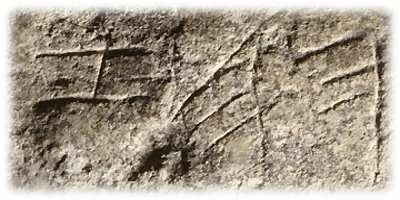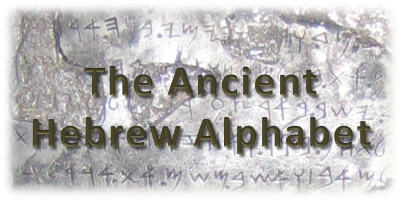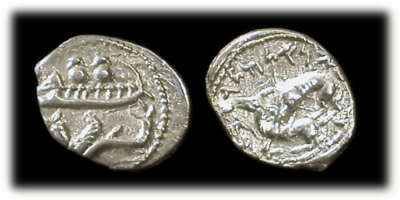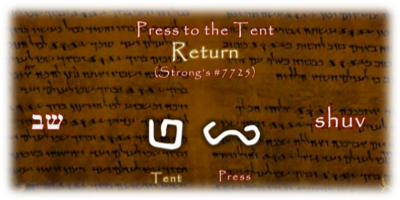In 1905, Flinders Petrie, a renowned Egyptologist and pioneer in modern archeology, discovered inscriptions of previously unknown symbols at Serabit el-Khadim.
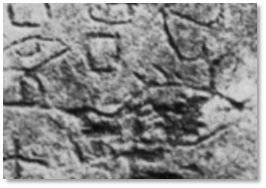
Dr. Alan H. Gardiner, another renowned Egyptologist, studied these inscriptions in detail. He discovered that these Sinaitic inscriptions consisted of a total of thirty-two symbols. Because of the limited number of symbols Dr. Gardiner determined that this was an alphabet.
Gardiner was then able to easily identify this Sinaitic alphabet as Semitic because of the pictographic nature of this alphabet. The name of each Hebrew letter is a Hebrew word with meaning.
The first letter of the Hebrew alphabet is called the aleph, a Hebrew word meaning "ox," The tenth letter is called the yud or yad meaning "hand" and the sixteenth letter is the ayin, a word meaning "eye."

Dr. Gardiner found that the letters in these ancient Sinaitic inscriptions were pictures of the very names of the Hebrew letters. The image of an ox head (left) was the letter aleph, the image of the hand (center) was the letter yad and the image of an eye (right) was the letter ayin.
This relationship between the pictograph and the names of the Semitic letters, Dr. Gardiner proposed, proved that this was the precursor to the previously known Phoenician/Old Hebrew alphabet.
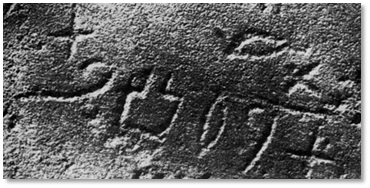
Once it was determined that the new script was Semitic, Dr. Gardiner, in 1916, was able to translate a portion of one inscription. This inscription includes the letters lamed, beyt, ayin, lamed and tav, which form the Semitic word לבעלת (l'balt), meaning "to the lady."
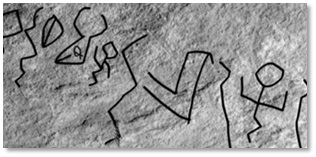
In 1999, John and Deborah Darnell were surveying ancient travel routes in the deserts of southern Egypt when they came upon another set of inscriptions very similar to the Sinaitic inscriptions found by Petrie.

Each letter represents a sound and a concept. The first letter,  (Note that Hebrew is read from right to left), is the aleph (pronounced ah-leph) and represents the "Ah" and "Eh" sounds. Aleph is a Hebrew word meaning "ox," and this letter is a picture of an ox head and represents the concept of "strength," from the strength of the ox.
(Note that Hebrew is read from right to left), is the aleph (pronounced ah-leph) and represents the "Ah" and "Eh" sounds. Aleph is a Hebrew word meaning "ox," and this letter is a picture of an ox head and represents the concept of "strength," from the strength of the ox.
The letter lamed,  , the twelfth letter, is a picture of a shepherd staff and represents the sound "L" as well as the concept of "authority," from the authority of the shepherd over the flock.
, the twelfth letter, is a picture of a shepherd staff and represents the sound "L" as well as the concept of "authority," from the authority of the shepherd over the flock.
When these two letters are combined, we have the Hebrew word 
 (EL, written as
אל in the Modern Hebrew alphabet, Strong's #410), the "strong authority."
(EL, written as
אל in the Modern Hebrew alphabet, Strong's #410), the "strong authority."
It is in the power of my hand to do you hurt. (Genesis 31:29, KJV)
This passage includes the Hebrew word EL, which in the King James Version is translated as "power." However, a better translation, based on the pictures of the word EL, would be "There is strength and authority in my hand to do you hurt."
Blessed be Abram of the most high God, possessor of heaven and earth. (Genesis 14:19, KJV)
This passage also uses the same Hebrew word EL, but in the King James Version it is translated as "God." Based on the pictures of the word EL, a better translation would be "Blessed be Abram of the most high strength and authority, possessor of heaven and earth." When we see the word "God" from a western perspective we see an old bearded man sitting on a throne in the clouds. When the ancient Hebrew's see the word "EL," they see the strength of an ox and the authority of a shepherd.
The Characteristics of the Early Alphabet
In our modern English Alphabet, each letter is associated with two characteristics, a form and a sound. The first letter of our alphabet has the form of "A" and has the sound "a". The Ancient Hebrew alphabet has four characteristics: form, sound, name and meaning. represents a sound. Each letter in ancient alphabets represented much more, pictograph (picture), syllable (name), mnemonic (meaning) and phonetic (sound). This unique relationship between the characteristics of the Hebrew letters is used to assist in reconstructing the original Hebrew alphabet and in turn will assist in root and word definitions and relationships.
Form (Pictographic)
Each Early letter is an obvious picture representing something concrete. The Ancient pictograph  represents a mouth, the
represents a mouth, the  represents an eye,
represents an eye,  represents a water, and the
represents a water, and the  represents the palm of the hand. Sometimes the picture of the letter is not as easily recognizable. For instance, the picture
represents the palm of the hand. Sometimes the picture of the letter is not as easily recognizable. For instance, the picture  may be difficult to determine. However, a thorough knowledge of the ancient Semitic people's culture and lifestyle will help to reveal the meaning of the pictograph. In the case of the
may be difficult to determine. However, a thorough knowledge of the ancient Semitic people's culture and lifestyle will help to reveal the meaning of the pictograph. In the case of the  , with an understanding of the semitic peoples tents we know that this picture is a perfect representation of the floor plan of the tent.
, with an understanding of the semitic peoples tents we know that this picture is a perfect representation of the floor plan of the tent.
Meaning (Mnemonic)
The mnemonic meaning of a pictograph is the extended meanings, related to the pictograph, usually related to the function rather than appearance of what the letter symbolizes. For example, the pictograph  has the extended mnemonic meanings of speak, blow and open. While each Hebrew letter has a name identifying the picture, the extended meanings can often be found in words derived from the name. For instance, the Hebrew word
has the extended mnemonic meanings of speak, blow and open. While each Hebrew letter has a name identifying the picture, the extended meanings can often be found in words derived from the name. For instance, the Hebrew word 
 (sin) literally means thorn, and the pictograph for this letter is a picture of a thorn. The word sin is a parent root and some of the other meanings of this letter are "hate, protect and grab." These ideas are found in the words derived out of this parent root which include; saney = hate, sa'an = pierce, sa'on = weapon, sinah = shield (protection). The idea of "grab" comes from the function of the thorn which is grab hold of the fur of an animal so that it can be transported to another location and also hate, which grabs hold of you, a weapon and shield, which you also grab hold of.
(sin) literally means thorn, and the pictograph for this letter is a picture of a thorn. The word sin is a parent root and some of the other meanings of this letter are "hate, protect and grab." These ideas are found in the words derived out of this parent root which include; saney = hate, sa'an = pierce, sa'on = weapon, sinah = shield (protection). The idea of "grab" comes from the function of the thorn which is grab hold of the fur of an animal so that it can be transported to another location and also hate, which grabs hold of you, a weapon and shield, which you also grab hold of.
Name (Syllabic)
Each pictograph is associated with, usually, a single syllable of two consonants. Besides this syllable being the name of the pictograph, it is also the Semitic/Hebrew word for what the pictograph symbolizes. The name of the pictograph  is peh and is also the Hebrew word for "mouth." Centuries before the ancient semitic pictographs were discovered, each Hebrew letter was identified with a name. As an example, the name of the Hebrew letter ר is resh, which is also the Hebrew word for "head." When the ancient pictograph letter
is peh and is also the Hebrew word for "mouth." Centuries before the ancient semitic pictographs were discovered, each Hebrew letter was identified with a name. As an example, the name of the Hebrew letter ר is resh, which is also the Hebrew word for "head." When the ancient pictograph letter  , clearly a picture of a "head," was discovered, it was not too difficult to figure out that this was the ancient form of the letter ר.
, clearly a picture of a "head," was discovered, it was not too difficult to figure out that this was the ancient form of the letter ר.
Sound (Phonetic)
The first letter of the syllabic name provides a singular sound for the purpose of forming words and sentences. The phonetic value of the pictograph  is "p."
is "p."

Like what you’re discovering? Continue the journey from Bible reader to translator.
|



